
As a leading economic power in Europe, Germany has been mired in a prolonged food price crisis in recent years. According to the latest data, food prices in Germany have risen by nearly 50% over the past four years, a rate far exceeding the growth of residents' income, even triggering social anxiety over "table inflation". From basic agricultural products to processed foods, from street snacks to high-end dining, almost all food categories have been affected. This phenomenon is the result of a complex interplay of factors such as energy costs, supply chain disruptions, policy adjustments, and climate change.
I. Energy Costs: The "Hidden Driver" of the Food Chain
The increase in food prices in Germany is primarily due to the continuous rise in energy costs. Data from the German Federal Statistical Office shows that energy prices in Germany rose by 34.7% in 2022, with natural gas prices surging by 64.8%. Energy costs permeate the entire food production, processing, and transportation chain.
The energy crisis has also exacerbated logistics costs. Germany's food transportation is highly dependent on road transport, and the increase in diesel prices has directly pushed up transportation expenses. Take coffee as an example. About 79% of the German population drinks coffee daily, but global coffee bean prices reached a new high in 1977 in 2024, with futures prices rising by 70% compared to the previous year. Although consumers feel the price increase with a lag of 6 to 9 months, coffee giant Nestlé has already announced a price increase, raising the price of 500 grams of coffee from 5 euros to 6.5 euros, a 30% increase.
II. Supply Chain Crisis: The "Butterfly Effect" in the Globalization Era
The vulnerability of the global supply chain has been exposed during the pandemic and geopolitical conflicts. Germany's food supply chain is highly dependent on imports, but events such as the Ukraine crisis and extreme weather have led to supply chain disruptions. Take orange juice as an example. Brazil, the world's largest orange exporter, has seen a sharp decline in production due to drought and frost, coupled with new EU regulations requiring proof of the legality of imported raw materials, which has pushed up the compliance costs for small and medium-sized farmers. Under the double pressure, the price of orange juice has continued to rise, and some brands have even halved the juice content to maintain profits.
In addition, the seafood supply chain has also been impacted. The average price of fish in Germany rose to 12.13 euros per kilogram in 2023, and the price of smoked fish exceeded 22.56 euros per kilogram in December. This phenomenon is the result of a combination of factors such as rising fishing costs, transportation delays, and environmental policies restricting catch volumes.
III. Policy Adjustments: The Double-Edged Sword of Tax Cuts and Price Hikes
To alleviate the pressure on people's livelihoods, the German government has implemented policies such as VAT reductions. However, the marginal effects of these measures are diminishing. In 2024, Germany abolished tax benefits for farmers, further increasing food production costs. At the same time, the termination of tax reduction policies for the catering industry led to a cumulative increase of 20.3% in restaurant consumption prices from 2021 to 2023.
On the other side of policy adjustments is the attempt at tax cuts. The German Minister of Agriculture once proposed to eliminate VAT on fruits, vegetables, and beans to counter high food prices. However, this proposal is difficult to implement under fiscal pressure. Meanwhile, the German government raised the minimum hourly wage from 12 euros in 2022 to 12.41 euros in 2024, directly pushing up prices in the catering and food processing industries. For instance, the price of Doner, a Turkish kebab, has risen from 4 euros in 2016 to 7 to 10 euros in 2024, with an average annual inflation rate of 11.8%.
IV. Climate Change: The Long-Term Shadow Over Agricultural Production
The impact of climate change on German food prices is long-term. The president of the German Farmers' Association, Lukas Weide, pointed out that one of the reasons for the soaring cost of fertilizers is the increase in natural gas prices, which is a key raw material for fertilizer production. Additionally, frequent extreme weather events have led to reduced crop yields. In 2023, German crop prices rose by 24.5% year-on-year, vegetable prices increased by about 20%, and beef prices rose by 18%.
Climate change also affects the supply of imported agricultural products. For example, global warming has led to a decline in production in the main cocoa-producing regions in West Africa, and the price of high-end products like Dubai chocolate may rise further in 2025. Data from the German Federal Statistical Office shows that German food prices rose by 2.8% year-on-year in 2025, although the increase was narrower than the 13.4% in 2022, it still poses pressure on low-income groups.
The soaring food prices in Germany are the result of the combined effects of the energy crisis, supply chain disruptions, policy adjustments, and climate change. This phenomenon not only reflects the fragility of the global economy but also reveals the contradiction between agricultural modernization and sustainable development. In the future, whether Germany can break this deadlock through policy innovation and technological breakthroughs will become an important window for observing the resilience of the European economy.

The hot candidate for the chairperson of the US Federal Reserve, Hassett, said that the president's policy opinions are important, but the mission of the Federal Reserve is to demonstrate independence.
The hot candidate for the chairperson of the US Federal Res…
Since 2022, the Fed has cumulatively reduced its balance sh…
On December 11 local time, the White House once again spoke…
Fiji recently launched its first green finance classificati…
Recently, the European Commission fined Musk's X platform (…
At the end of 2025, the situation in the Caribbean suddenly…